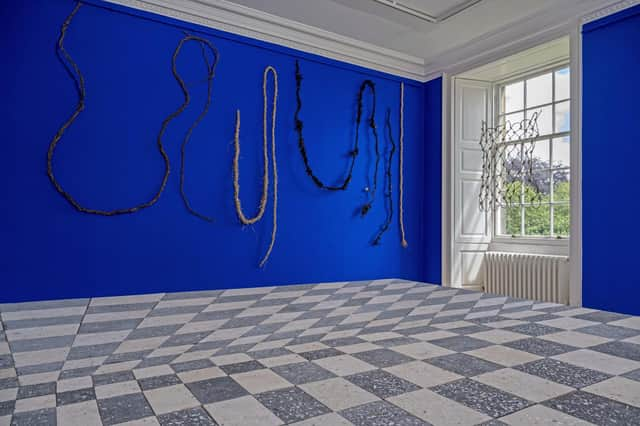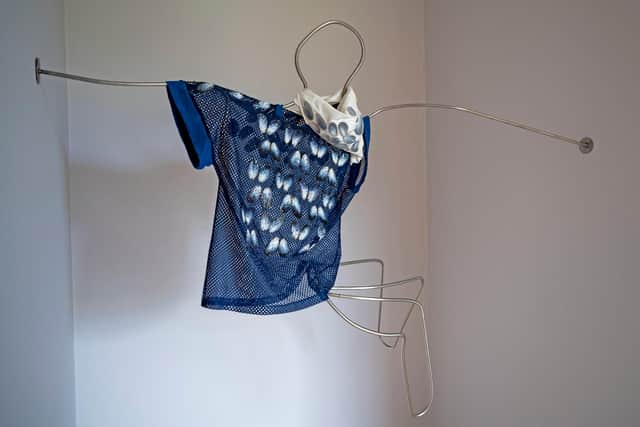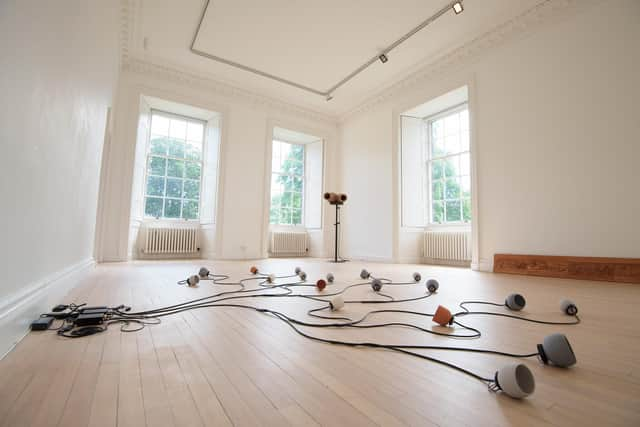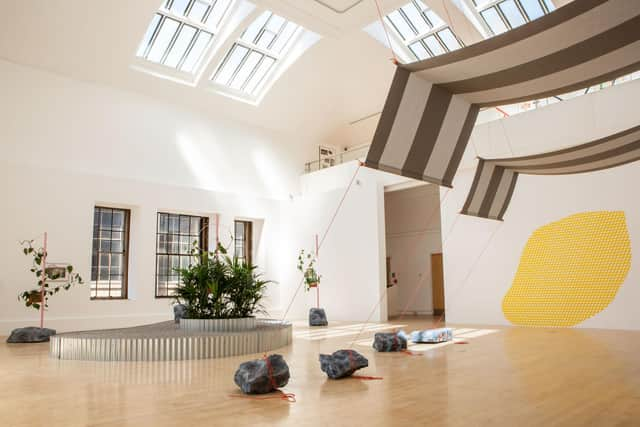Edinburgh Art Festival reviews: Cooking Sections & Sakiya | Celine Condorelli | Ruth Ewan


Cooking Sections & Sakiya: In the Eddy of the Stream, Climate House, Edinburgh ****
Celine Condorellli: After Work, Talbot Rice Gallery, Edinburgh ***
Ruth Ewan: The Beast, Collective, Edinburgh ***
Advertisement
Hide AdOne of the dominant trends in contemporary art at the moment is art which is more than just art. This is art as science, ecology, architecture, product design, even politics, which finds a home in the art world, in some cases more comfortably than others.
Like most of the members of Assemble, who won the Turner Prize in 2015, art collective Cooking Sections (Daniel Fernández Pascual and Alon Schwabe) trained as architects, and they were Turner shortlisted themselves in 2021. Their interest is in food and ecology, creating eddies which reverse, in small ways, the trend towards climate change catastrophe. Their best known project is Climavore, for Skye-based Atlas Arts, which began as an outdoor installation and turned into a much wider campaign to inspire locally sourced alternatives to farmed salmon.
One has the sense that the locus of Cooking Sections’ work lies outside art galleries, but they have worked hard to create a show in Climate House. Their research project with Royal Botanic Gardens scientists about the symbiotic relationship between wild salmon and Scottish forests is better suited to a scientific paper than an exhibition space, but they do their best. There are mosaic panels and floor tiles made from an eco-friendly cement which uses crushed mussel and oyster shells, and ropes made from heather, seaweed and moor grass.
Where the artistic imagination takes off the most, however, is in the oyster readings (weekends only, book in advance, get one if you can), a kind of bivalve divination. Starting from the fact that an oyster is a book of its own history, its layers recording good and bad years, climate shifts and so on, it spins out into an insightful journey into what interests us most: ourselves.


The lower floor of Climate House is given over to Sakiya, a farm, research base and art project in the occupied territories about 7km from Ramallah, to which Cooking Sections donated their Turner Prize money. In a work called Recalling Recollection, they eloquently show how plant cultivation quickly becomes about land ownership, colonisation and freedom itself. The attempt to link all this to land issues in Scotland felt too broad-brush too be useful; it’s enough as it is.
The work draws preserved samples from RBGE’s collection for the 33 “weeds” so classified by the British during their occupation of Palestine because they threatened the wheat monocultures they wanted to grow. These are displayed alongside postcards from Palestine in English and Arabic, proverbs and folktales woven around the plants, or information about their uses as food or medicines: two radically different perspectives on the same species.
Advertisement
Hide AdThe second room is given over to “sound scarecrows” used on the farm to ward off or attract (depending on the time of year) wild boar. A suite of pottery vessels plays an undulating song like a kind of Greek chorus, strange and rather beautiful. I left feeling I’d learned a lot, but also experienced something of the transformational magic which might be art.
Céline Condorelli also trained as an architect and it helps to know this approaching her first major survey exhibition at the Talbot Rice Gallery. This is a show about space, about playing with notions of indoors and outdoors, and about structures – physical and metaphorical – for work, sport, play, even museums.


Advertisement
Hide AdFirst up is an indoor garden, referencing Brazilian modernist architect Lina Bo Bardi and Condorelli’s own installation for London’s King’s Cross. Then there is a dark, closed-in space showing prints made during a long-term engagement with a Pirelli tyre factory near Turin. While the project sounds fascinating – particularly her interventions in the production line – the prints don’t tell a story unless one reads the extensive accompanying text.
The work which feels most like art is the title piece, After Work, a film about the construction of a play park in a South London estate by Condorelli, made with filmmaker Ben Rivers and poet Jay Bernard. Play is a major theme in the show, which includes Condorelli’s research into mid-century Dutch architect and designer of play parks Aldo Van Eyck, and Palle Nielsen’s 1968 experiment which turned a museum in Stockholm into an adventure playground.
In the display alcoves upstairs in the Playfair Gallery, once used for natural history specimens, we see some of Condorelli’s research materials: her precise architectural sketches and colour experiments, glass models of sea creatures from the 19th century, chromatic circles and an 18th century device for measuring the blueness of the sky.
The final installation, Thinking Through Skin, is said to be an exploration of colour, particularly the intuitive colour-changing capacities of squid and cuttlefish. What is presented, however, is a space of dreamy music and billowing curtains which shows objects from Edinburgh University’s museum collection and works by Condorelli’s collaborators (Ben River’s compelling film Urth among them).


If you’re expecting a solo show, it takes a while to work out what you’re looking at. Condorelli seems to have designed the space in order to bring this group of works together, though I could not sense a curatorial arc or a conversation between them. The exhibition as a whole feels primarily architectural, sheltering awkwardly under the umbrella of art.
Ruth Ewan is definitely an artist, her work distinctive because of her interest in social justice, alternative systems and radical history. She, too, begins with extensive research, often making work which is both nuanced and opinionated, but it’s the first of these which is missing as she squares up to Andrew Carnegie, Scot, steel magnate, philanthropist and one of the richest men who ever lived. In a new animated film, The Beast, Carnegie is forced into a conversation with the dinosaur which bears his name – Diplodocus Carnegii – challenging him about capitalism, workers’ rights and the exploitation of the earth’s resources.
Advertisement
Hide AdSpecifically, Ewan homes in on the Homestead Strike at his Pittsburgh steelworks in 1892 when workers protesting a 15 per cent pay cut were locked out and violence ensued in which ten people died. Their names are listed on the wall in a kind of memorial, and there is a thoughtful display of archival items. The unrest enabled Carnegie and his partner Henry Clay Frick to end unionisation in the plant, slash wages, increase working hours and achieve record-breaking profits. “I got rich by hard work,” protests Carnegie. “Whose hard work?” the dinosaur quickly counters.
Carnegie, who was both celebrated and lampooned in his lifetime, is a cartoon figure in a kilt, whining that the creature addressing him is surely a product of indigestion. The dinosaur gets all the best lines, calmly reiterating that its kin survived some 100,000 years without “pulling out the innards of the earth to make weapons”. Who, you might ask, is the dinosaur now?
Advertisement
Hide AdAt a time when we are revisiting and revising our opinions of so many Victorian heroes, it’s fair to point out that Carnegie was a ruthless capitalist as well as the builder of 2,500 libraries. But the scales are weighted against him from the start (“Your workers would have preferred a living wage,” the dinosaur sneers). The use of animation implies simplification, as if the arguments put forward are no more than child’s play. But the debate needs more nuance; there are plenty who still benefit from Carnegie’s largesse. Normally so careful in picking her targets, this time it feels like Ewan has slightly overshot.
Cooking Sections & Sakiya until 18 September; Celine Condorelli until 1 October; Ruth Ewan until 18 September. For full Edinburgh Art Festival listings, see www.edinburghartfestival.com